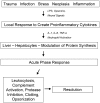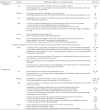Acute phase response in animals: a review
- PMID: 20034426
- PMCID: PMC2798837
Acute phase response in animals: a review
Abstract
The acute phase response is a complex systemic early-defense system activated by trauma, infection, stress, neoplasia, and inflammation. Although nonspecific, it serves as a core of the innate immune response involving physical and molecular barriers and responses that serve to prevent infection, clear potential pathogens, initiate inflammatory processes, and contribute to resolution and the healing process. Acute phase proteins, an integral part of the acute phase response, have been a focus of many applications in human diagnostic medicine and recently have been identified in common animal species. Potential applications to diagnosis, prognosis, assessment of animal health, and laboratory animal welfare are readily apparent.
Figures




References
-
- Abernethy JT, Avery OT. 1941. The occurence during acute infections of a protein not normally present in the blood. I. Distribution of the reactive protein in patients' sera and the effect of calicum on the flocculation reaction with C polysaccaride of Pneumococcus. J Exp Med 73:173–182 - PMC - PubMed
-
- Alper CA. 1974. Plasma protein measurements as a diagnostic aid. N Engl J Med 291:287–290 - PubMed
-
- Armstrong PB, Quigley JP. 1999. Alpha2-macroglobulin: an evolutionarily conserved arm of the innate immune system. Dev Comp Immunol 23:375–390 - PubMed
-
- Arthington JD, Eichert SD, Kunkle WE, Martin FG. 2003. Effect of transportation and commingling on the acute-phase protein response, growth, and feed intake of newly weaned beef calves. J Anim Sci 81:1120–1125 - PubMed
Publication types
MeSH terms
Substances
LinkOut - more resources
Full Text Sources
Other Literature Sources
